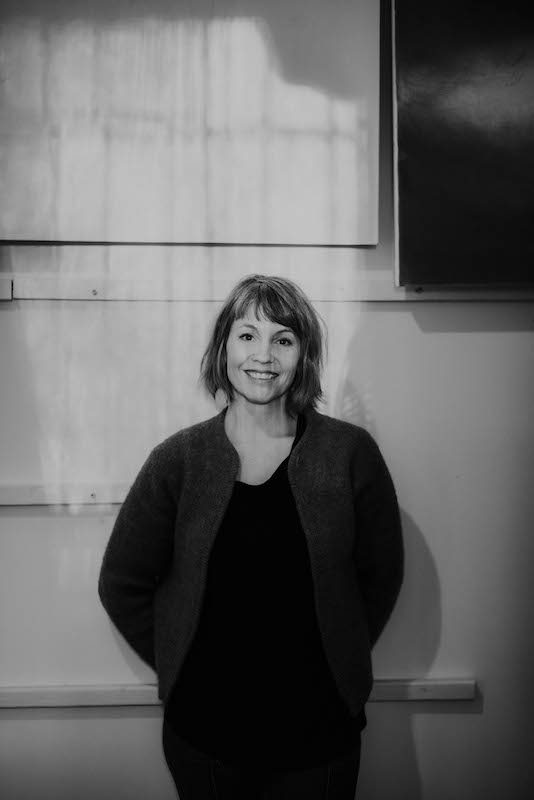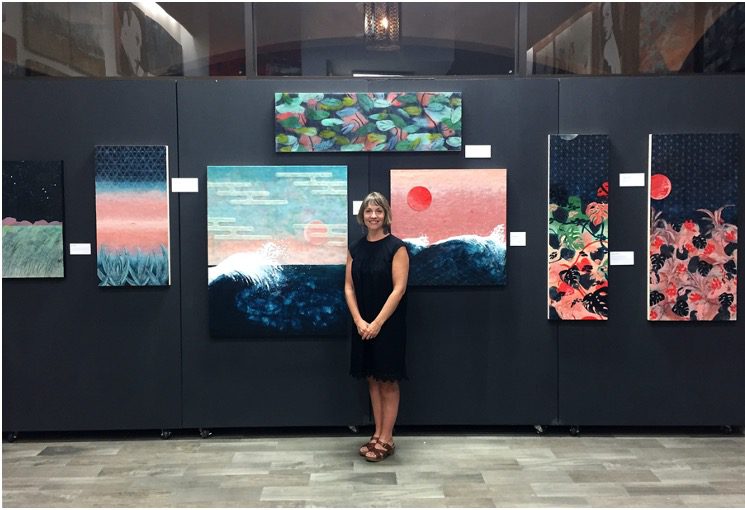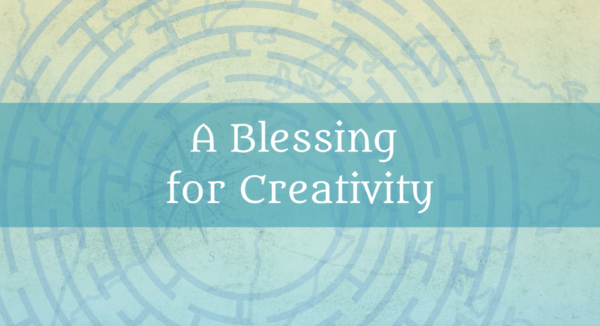I am delighted to share a beautiful submission to our Monk in the World guest post series from the community. Read on for Natalie Salminen’s reflection on creativity, faith, and painting the liturgy of the hours.
I was exhausted in every sense of the word. As a mother to three, foster parent, visual artist, pastor’s wife, school volunteer, and small business owner, I was struggling to keep up with life’s daily demands. In the midst of this busy season, I longed to be true to my artistic practice, knowing well the power of creativity to heal and align. My husband and I decided to open up a brick and mortar art studio and poetry showroom, naming it Studio Haiku. Though this felt like the right decision, at the time there was no denying I was dwelling in a very weary place.
Unfortunately my artistic practice had become a series of what I had deemed “difficult births.” The creative energy was present, but the joy and celebration in the arrival of completed work had been waning. I felt relief and a deep gratitude for a fleeting moment, but soon the labor pains began again with the next project. I had not scheduled any downtime or intentional rest between deadlines. So many labor pains, and less and less energy to draw from as time went on. I cried out to the Spirit for relief, but would inevitably press forward without pause. Another project, another body of work…and so the cycle continued. I longed for rest.
In an effort to paint without the pressure of performance or outcome, I arranged a painting trip to Mexico in the fall of 2018. I thought this might be a path towards the rest I was seeking. I had been working with a gallery in the Baja peninsula in the southern town of San José del Cabo since 2014, and over the years had planned each trip around a solo show or a workshop that I would be teaching. This time however, I wanted the trip to be about painting for the joy of it – no deadlines, no expectations. Nothing required of me. I imagined myself painting, relaxing, and enjoying the beauty of Mexico. I would later deliver whatever paintings I had completed to the gallery. It sounded simple to me, restful. No grueling labor pains or difficult births required.
That did not happen.
Much of my work centers around encaustic, a beeswax and damar resin medium, which entails painting layers upon layers of pigmented beeswax medium on a birch panel in an effort to build up the surface of the painting. So to prepare for my easy-going week of painting in Mexico, I readied and primed seven large panels with many, many layers of encaustic medium in an effort to finish what can be for me the most time consuming component of the encaustic process. After I had completed most of the under painting, I had the panels shipped to Mexico, where I would later bring the paintings to completion.
Upon my Baja arrival, I met the gallery owner to discuss what I would be delivering to her at the end of my ten day trip. She excitedly told me that the timing of my visit could not have been more perfect, as many of her gallery clients were currently in the area. She immediately asked if I would be open to having a formal solo show. I knew that meant producing a cohesive body of work, having a formal opening, presenting my work with an accompanied artist’s talk, all by opening night. As she laid out her plan, I felt a “yes” rise up from within me. What was happening? In an out-of-body moment, I agreed to do the show.
Back at the studio, I quickly condemned myself for agreeing to what seemed to be the stark opposite of what I had come to Mexico for in the first place. Frustrated with myself and my weak constitution, I had nothing to do but begin painting. I painted day and night, nearly eighteen hours a day. As I continued to build up the layers of paint, I trusted that something thematic would emerge, as my usual process rarely includes contriving an image beforehand. The pressure was mounting as I reminded myself that I had just committed to showing a cohesive body of work in ten days time. I wasn’t sure how everything would to tie together, and of course my artist’s talk would derive from the theme, so working on that element would also have to wait. I prayed, I prayed, I prayed. Painting and praying. Painting and praying. Praying and soon enough, tears.
It was just three days before opening night and still no theme, no central subject. No cohesive imagery that I could see. I had been translating the Japanese sewing art of sashiko into many of the paintings through a drawing process, but pursuing the subject of Japanese pattern work as the theme did not settle with me, as much as I tried. I began to feel intense panic and fear settle into my being. I cried out to God, “Why is this happening to me? Why did I say yes to this? I thought I would be able to finally rest! To paint without pressure. Now I’m so tired and anxious and my back is against the wall. Why did I say yes to this??” I berated myself. What was I to do now?
I had finished five paintings. I could see no common thread between them apart from each painting containing natural elements of the Baja landscape. Five paintings were not enough for a full show and I knew it. But how could I pull them together and add more work in just a few days? How would I talk about them? Where was my theme? All I could think about was how scared I felt with the threat of failure and embarrassment looming near, and how physically tired I was from all the late nights. My thinking was clouded by the stress and shame.
All I wanted to do was rest. I wanted to lay my tired body and heart down and not get up. In an effort to refocus, I walked out of the studio with my books and journal, found a chair in the sun overlooking the Sea of Cortez and crumpled into a teary ball. I was so frustrated with myself. I opened a book I was working through, entitled The Artist’s Rule, by Christine Valters Paintner. I turned to the chapter “Sacred Rhythms for Creative Renewal” which began with a quote from Linda Leonard, reading,
“A major obstacle to creativity is in wanting to be in the peak season of growth and generation at all times…but if we see the soul’s journey as cyclical, like the seasons…then we can accept the reality that periods of despair or fallowness are like winter – a resting time that offers us a period of creative hibernation, purification and regeneration that prepares us for the births of spring.”
The words stung. The chapter was all about creating space for rest and renewal. I rolled my eyes bitterly and thought, “This isn’t helping me right now! I don’t have time to rest. I already know I need it, but I am in panic mode!”
I read on and a quote from J. Phillip Newell became another uncomfortable exposure of my weakened heart.
“If we fail to establish regular practices of stillness and rest, our creativity will be either exhausted or shallow. Our countenance, instead of reflecting a vitality of fresh creative energy that is sustained by the restorative depths of stillness, will be listless or frenetic. This is as true collectively as it is individually, and applies as much to human creativity as it does to the earth’s fruitfulness. Creativity without rest, and productivity without renewal, leads to an exhaustion of our inner resources.”
I cringed as I read. Oh, how I could relate. The chapter expounded on prescriptives for resting in God and creating space for pause throughout the day. One such recommendation by Valters Paintner was, “…the ancient tradition of praying the Liturgy of the Hours, with its seven holy pauses.” I read on to understand that this ancient call to pray and praise seven times throughout the day is based on Psalms 119:164. The Liturgy of the Hours begins in the pre-dark dawn and ends in the dark of night. It is a rhythm of pausing, connection and a gratuitous invitation to rest in God’s presence throughout the day.
My mind was contemplating the invitation, but still threatened by my immediate circumstances. I continued to read from the author’s wisdom, “Creativity depends on waning times for restoration…In cultivating our creativity, times of rest are essential. Pushing ourselves to the edge of exhaustion does not nurture the creative process in the long run.”
“Very funny!” I said angrily to God. “I’ve been telling you how tired I am, and now you’re again inviting me to rest and that’s the last thing I have time for right now! Why did I say yes to this?? I am up against the wall, I am panicking, I have no idea how to pull this all together, and I I have two days to do it in. I NEED YOU. I need you to show up for me right now. I know I need to rest and be still, but I don’t know how to actually do that right now.” I was conflicted. I was blaming myself for getting into a tight spot once again, a bad habit for which I didn’t know how to break. But I still had enough hope and belief in God’s goodness to ask Him to make a way for me. He had shown up for me before, and I believed he would do it again. I tried to push aside the crippling worry and continued to pray for a way to be made.
I walked back into my studio and surveyed the five paintings I had thus far completed. What I saw before me brought me to my knees. Unseen by me until that very moment, each painting was of a different time of day. I was undone. I’m not exactly sure how to communicate what transpired in my heart at that moment, but I quickly realized that I was on pure and holy ground. The scales fell. God had been there all along, supporting me in my deep unrest.Immanuel. Unbeknownst to me, we had been painting The Liturgy of the Hours together.
There before me was Vigils:Pre-Dawn. a painting of a dark and starry sky, with just enough light to see a field of green grasses beginning to awaken beneath it. There was Lauds:Dawn with it’s sunrise pink sky being pierced by a sliver of gold-leafed sun, rising over the Sea of Cortez. Sext: Noon stood finished as well, donning a beautiful Japanese-red sun, hanging high-noon and full over the bright and active sea. The piece that would become Vespers: Evening had a twilight sky already painted in, complete with a glimpse of the moon at the top of the painting and a small, matching slice of sun at the bottom. This magical in-between time had been painted so particularly that I gasped. I also had finished what would become Compline:Night. A starscape and a warm, glowing moon rose quietly above the lush flora of Mexico. It met my eyes with growing astonishment. Each of the five completed
paintings fit perfectly into the set times for the Liturgy of the Hours. Before I had read about the Liturgy of the Hours, these five paintings had come to completion.
The two other times for prayer, None: Afternoon and Terce: Morning, were left for me complete. Although I would need to pull an all-nighter in order to complete the series, I went forward to paint with the most exuberant and holy glee anyone could ever imagine. I would no longer be creating out of exhaustion and anxiousness, but from a place of miracle. I could rest, knowing God was at my creative helm. My panic was replaced by amazement, as I leaned into the co-creation I had just witnessed. The God of the Universe had met me. Met me in my need. Met me in my weakness. He had soothed my anxious heart in the most tangible way, with the most miraculous and generous gift.
The show’s theme was clearly Liturgy of the Hours – seven large paintings to reflect the seven holy pauses. The experience made the most extraordinary artist talk on opening night, as I told the gallery attendants just exactly what had happened. On a warm Baja night, the invitation to rest was before each of us – profound and holy, a visible manifestation of the miraculous power of a loving God, who meets us generously in our time of need.
Four years later and I am often tempted to forget this extravagant miracle. (I understand the Israelites of old now more than ever). For me, the “exhaustion of inner resources” comes quickly when I draw from my own strength, create out of my own silo of being or dwell in false shame. Since that experience in the Baja, I discover daily that rest is trust. I can trust that I am co-creating with the Father, Son and Holy Spirit. Rest is knowing that truly, my weaknesses make room for God’s glory. I have learned that my weakness makes space for a miracle. That is a hard one to believe, but it is true. When I’m in the studio I remind myself that We are making things together and I can trust that. This postures me towards a restful spirit, because trust is rest; the doorway into true creative partnership with the Godhead.
This encounter also opened up the door for me to accept that my very own winter season was coming. God made a way and in the spring of 2020, just as the pandemic was unfurling, I closed my brick and mortar studio. It was a bittersweet necessity. I would take the next year off. I could “see the soul’s journey as cyclical, like the seasons” and was given much courage to embrace the fallowness that would soon arrive. Just before God would ask me to close the studio, I created a series of encaustic and Japanese paper vases that held dried winter flora, entitled Nature at Rest. It was a prophetic co-creation that made the closing of the studio less painful. I knew from those small sculptures that a fallow season was an essential part of life and quite beautiful in its own way.
Here we are now in the spring of 2022 and this story continues to unfold. We’ve navigated two full years of pandemic living, and none has gone unscathed. Violence, tragedy, and the spirit of division lounge boastfully in our town squares. A nebulous unrest simmers, incessantly knocking at the door of our innermost being. We want this all to be over. We want a break. We want to rest. The scriptures tell us that Christ gives rest to those who are labored and weary. Is that not us? In my Mexican sea-side studio, God did not immediately give me the thing I thought I wanted. He instead turned my face to see His. It was the Who of rest, not the how. Once I saw that Christ was with me, in my humanness, in my weakness, deeply steeped in my particularities, rest ceased to be such a bitter struggle. My calendars and commitments look different now, as I desire to live under His banner of rest and nearness – powerful truths to to ground our flailing hearts. Today, amidst the darkness of our times, that same Rest, which does not discriminate, is being offered to us. We need only turn our gaze.
View the Liturgy of the Hours Series.

Born in Duluth, Minnesota, Natalie Salminen Rude credits her years of travel, a deep appreciation for the natural world around her, esteem for community, and a genuine wonder threaded with intense curiosity for all that life holds – for having laid the foundation for a rich zest for life and the artistic process. In 2003 she received a BFA with honors from the University of Wisconsin, Superior. Although graduating with a concentration in painting, she also studied extensively in ceramics, textiles and sculpture. In 2004, she began working in encaustic. Encaustic has become for her a valued medium as it allows for physicality, creative mixed media additions, use of poetic text and ultimately a powerful employment of color; each being vital components of her personal aesthetic and process.
Natalie now resides near the shores of Lake Superior in Duluth after time spent in Europe, South America, the Middle East, Mexico and lastly Ontario, Canada, where she, her husband, and three children called home for four years. Working professionally in the arts since 2004, she maintains a studio, teaches encaustic workshops both locally and internationally, exhibits and facilitates discussions on spirituality and what it means to live as an artist within the context of commitment.



